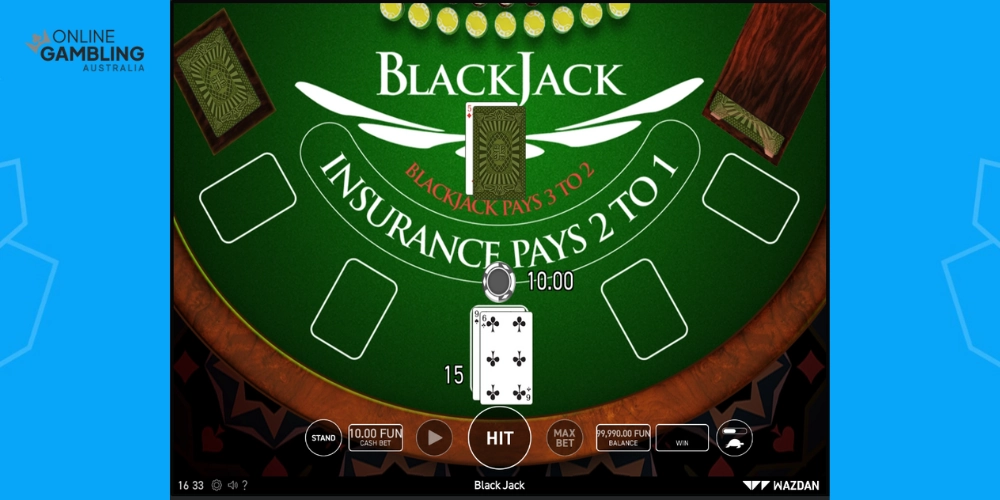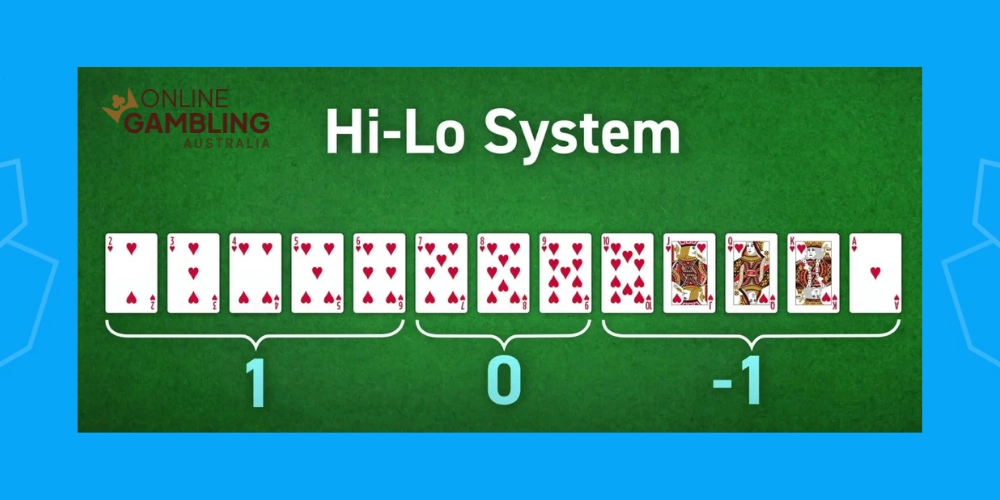
Skycrown Casino

Skycrown Casino
In the heart of Australian blackjack, card counting offers players a tantalising advantage. Explore the art and strategy behind this renowned skill, and uncover how mastering it can shift the odds in your favour.
Choosing the right online casino is paramount, the best platforms guarantee not only a vast selection of games but also ensure security, fairness, and quality customer service. A superior online gambling experience is rooted in trust and quality, making your choice critical. Below, our list of online gambling sites showcases the leading platforms in AU that embody these essential attributes.




Card counting is a strategic method employed by blackjack players to gain an advantage over the casino. At its core, card counting involves tracking the distribution of high and low cards in the deck to predict future hands. By assigning specific values to each card and maintaining a running count, players can adjust their bets and decisions based on the likelihood of favourable outcomes.
This technique, while rooted in statistics and not illegal, is frowned upon by many casinos. Players leveraging this strategy when playing blackjack for real money should be aware that some establishments might disallow its use. Exercising discretion and caution is paramount to avoid potential consequences or bans.
Card counting’s origins trace back to the 1960s, with Edward O. Thorp’s groundbreaking book “Beat the Dealer.” Thorp’s mathematical approach revolutionised the game, paving the way for successive generations of counters. Over the years, the strategy has evolved, adapting to casino countermeasures and incorporating technological advancements.
Card counting operates on a simple yet effective principle. As cards are dealt in a game of blackjack, players assign a numerical value to each card, and then track these values to maintain what’s known as a “running count”. Here’s a breakdown of the process:
1. Assigning Card Values: Typically, cards 2-6 are given a value of +1, cards 7-9 are valued at 0, and 10s, face cards, and Aces are assigned a value of -1.
2. Maintain a Running Count: As each card is dealt, players adjust their count based on the value of the card. For instance, if a 2 is dealt, you’d add one to your count.
3. Calculate the True Count: Especially in games with multiple decks, the running count isn’t enough. Players must determine the “True Count” by dividing the running count by the estimated number of decks remaining. This provides a more accurate representation of card distribution.
4. Adjusting Bets: With a positive true count, indicating a higher concentration of 10s, face cards, and Aces left in the shoe, players might opt to increase their bets as the odds are in their favour. Conversely, a negative count suggests betting conservatively.
While the mechanics of card counting are straightforward, mastering the technique requires practice and quick calculations under the pressures of live gameplay. It’s also crucial for players to remember that while card counting is not illegal, many casinos view it as undesirable and might take measures against suspected card counters. Always being discreet and respectful is key to avoiding drawing unwanted attention.

In brick-and-mortar casinos, card counting thrives on live gameplay and tangible decks. Players can gauge deck penetration and sometimes even spot dealer tells. Online platforms, with random number generators, present a different challenge. Some online games reshuffle after each hand, making counting ineffective. However, live dealer online blackjack might offer counting opportunities, though the speed and deck penetration vary.
In the vibrant world of Australian blackjack, card counting stands out as a strategy for those seeking to shift the odds in their favour. While it holds the allure of potential rewards, like all strategies, it comes with its distinct set of benefits and challenges. Understanding these aspects can guide players in deciding whether this approach aligns with their gameplay ambitions.
Card counting, when mastered, offers blackjack players a suite of advantages that transcend mere gameplay. From gaining a mathematical edge to making better educated decisions, the advantages of this strategy are enticing for those willing to invest in the effort.
While card counting holds undeniable allure, it isn’t without its challenges Players must be prepared for potential pitfalls, from facing casino restrictions to the demands of practising the strategy itself. Awareness of these drawbacks is crucial for those considering this approach

The realm of card counting is not monolithic; it boasts a variety of systems, each with its unique approach and level of complexity. Understanding the nuances of these systems can empower players to select one that aligns with their skill level and gameplay style.
The Hi-Lo system is perhaps the most popular and widely recognised counting method. In this system:
The simplicity of the Hi-Lo system makes it a favourite among beginners. Players maintain a running count, adjusting it with each card dealt based on these values. When the count is high, it indicates a remaining deck rich in high-value cards, which is beneficial for the player.
Multilevel count systems introduce a more intricate card valuation system, with cards potentially holding values beyond just -1, 0, and +1. These systems aim to offer a more precise estimation of the deck’s composition, but they also demand greater mental agility from the player.
For instance, some multilevel systems might assign a value of +2 or -2 to specific cards, making the counting process more detailed. While they can provide a more refined edge, they also carry a steeper learning curve and are typically favoured by more experienced counters.
Apart from the primary running count, side-count systems require players to maintain an additional count, usually of specific cards like Aces. By keeping a separate tally for these cards, players gain more insight into the deck’s composition, allowing for more informed betting decisions. However, managing multiple counts simultaneously can be challenging, especially under the fast-paced conditions of a live casino game.
The basic counting methods, while effective, just scratch the surface of the sophisticated techniques employed by seasoned card counters. These advanced methods aim to exploit more nuanced aspects of the game, and help you to win while playing Blackjack.
Each of these advanced strategies demands a deep understanding of the game, impeccable attention to detail, and consistent practice. They also increase the player’s edge, but the trade-off is a heightened risk of detection by casino staff, given the more overt nature of some of these techniques.

Venturing into the world of card counting can be both exhilarating and challenging. As with any skill, mastery comes with consistent effort, practice, and a keen understanding of the nuances involved. While the strategies and systems lay the foundation, it’s the pragmatic approach to gameplay and self-management that truly sets apart the amateurs from the pros. Here are some invaluable tips to guide aspiring card counters on their journey:
Practice Regularly: Start with a single deck, then challenge yourself with multiple decks or distractions.
Manage Bankroll: Set loss limits and stick to them. This discipline is vital for long-term success.
Stay Inconspicuous: Vary bet sizes within reason and avoid drawing attention with sudden large bets.
Continuous Learning: The world of blackjack is ever-evolving. Stay updated with new strategies and casino policies.
Blackjack, a game of both chance and skill, has enraptured many with its enticing promise of beating the house. Card counting elevates this challenge, turning the tables (quite literally) in favour of the player. In the vast expanse of Australia’s gambling landscape, understanding and mastering card counting can offer a significant edge. However, it’s crucial to remember the fine line between strategy and casino policies.
While the art of card counting is legal, casinos, as private establishments, reserve the right to set their own rules. Some might even share information about prolific counters. So, while you immerse yourself in the world of counts, aces, and decks, always play with respect, know the house rules, and cherish the thrill of the game. After all, it’s not just about winning; it’s about playing the game the Aussie way!
The time it takes varies from person to person. While some might grasp the basics in a few days, mastering the skill, especially in a live casino environment, can take months of consistent practice.
Yes, several apps and online platforms simulate blackjack games and are specifically designed to help players practise card counting. These tools provide feedback on accuracy and speed, helping aspiring counters refine their skills.
While card counting isn’t illegal, casinos in Australia, like many other places, reserve the right to refuse service to anyone. If they suspect you of card counting, they might ask you to leave or bar you from playing blackjack.
Multiple decks complicate card counting as they dilute the effect of individual cards on the overall composition of the shoe. This led to the development of the True Count, which adjusts the running count based on the number of decks remaining.
Aggressive bet spreading, where players drastically change their bet sizes based on the count, can lead to larger profits but also attract attention. Casinos are vigilant for such patterns, and it can be a clear giveaway of card counting.
Online live dealer blackjack brings the real-table experience to the digital realm. While it offers an opportunity for card counting, there are challenges. Game speeds might differ, and deck penetration can be shallow, meaning the dealer shuffles more frequently. As always, it’s essential to adjust strategies based on specific game conditions.
Beginners are often advised to start with solo card counting. It allows them to grasp the fundamentals and hone their skills without the complexities of team coordination. Once proficient, they can explore team play, which offers advantages like dividing tasks and pooling resources but also requires trust and seamless communication.